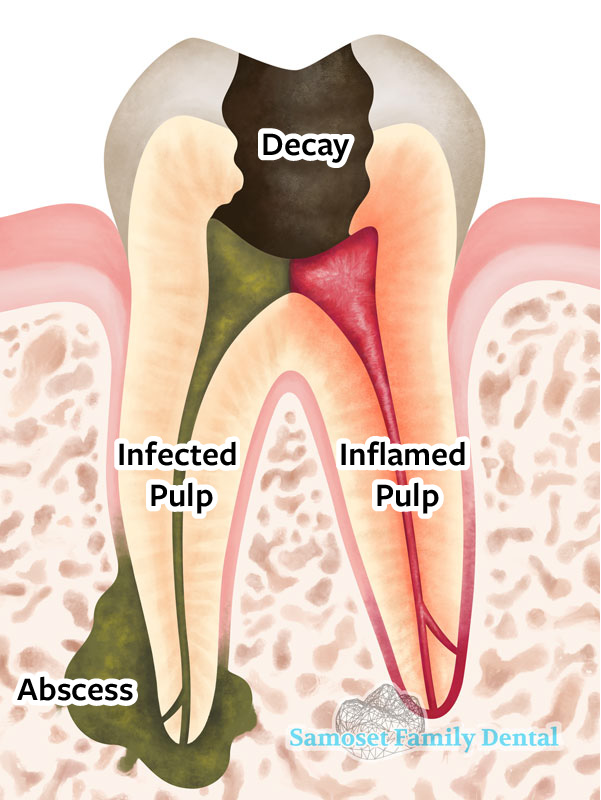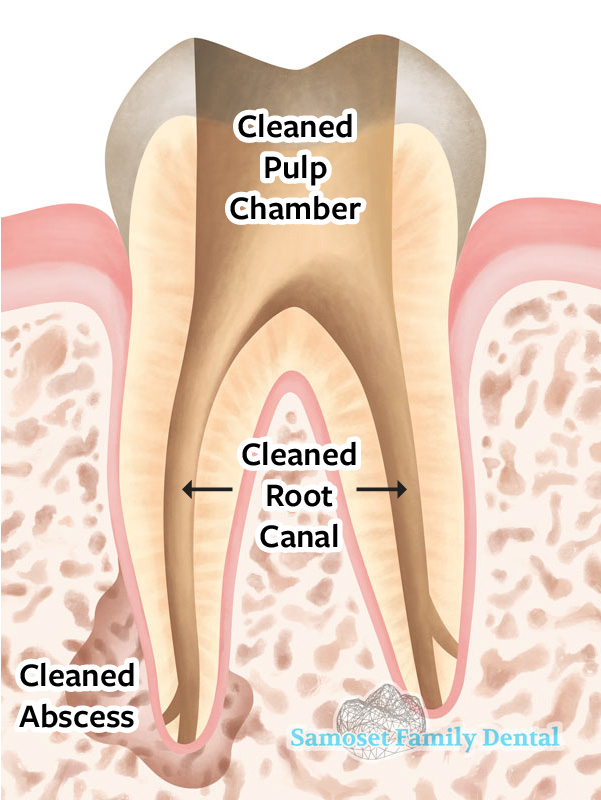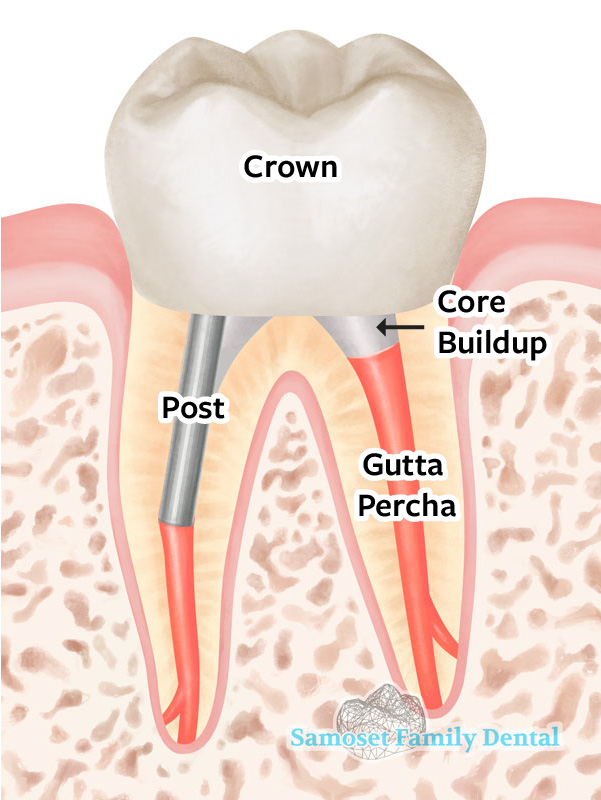Root Canal Therapy in Plymouth MA

More than 15 million root canals are performed each year in the US. It is one of the most common dental procedures. Root canal therapy deals with the complex structure found inside the teeth, such as tooth pulp, nerves and arterioles.
When the tooth is infected, the nerves inside the tooth need to be removed, and a root canal treatment needs to be initiated in order to get rid of the infection and preserve the tooth. If left untreated, an infection can turn into an abscess, which is a much more serious problem by possibly spreading the infection to the surrounding vital structures in the head and neck area.
How to tell if a tooth is in need of a root canal?
- Teeth that are sensitive to cold and hot food, or having spontaneous pain
- Teeth that are tender when chewing and biting
- Swelling and tenderness in the gums
- Teeth that are discolored
- Teeth that are dislodged due to injury
Clinical Steps of Root Canal Therapy



Root canal therapy usually takes one to three visits to complete. Digital radiographs will be taken before the treatment begins.
- Initially, the tooth will be totally numbed by local anesthesia. A dental rubber dam (protective sheet) will be placed to ensure the surgical area remains free of microorganisms in the saliva and to ensure the patients’ safety.
- An opening will be created on the tooth and the infected nerves will be completely removed. The canals will then be cleaned and shaped and completely sealed by a biocompatible material called gutta percha. A temporary filling will be placed prior to the permanent restorations.
- Crowns are strongly recommended for teeth after root canal therapy especially for posterior teeth, because crowns will prevent the tooth from fracture, increase the success for root canal and improve the appearance. Read more about crowns on our Crowns and Bridges page.
Does Root Canal Therapy Hurt?
Root canal therapy is used to relieve pain. Most people who have root canals admit they did not experience any pain during the appointment and felt better afterward. It is not uncommon that patients fell asleep during the procedure with Dr. Sheng in our office.
How Much Will the Procedure Cost?
The cost varies depending on how severe the problem is and which tooth is affected. Molars are more difficult to treat and usually cost more. Most dental insurance plans provide coverage to this procedure at 80% of the total cost. Generally, root canal therapy and restoration of the natural tooth is less expensive than the alternative of having the tooth removed. An extracted tooth must be replaced with a bridge or implant to restore chewing function and prevent adjacent teeth from shifting. These procedures tend to cost more than root canal therapy and appropriate restoration.
Office Hours
| Mondays | 9:00am–6:00pm |
| Tuesdays | 9:00am–6:00pm |
| Thursdays | 8:00am–5:00pm |
| Saturdays | 8:30am–4:30pm |
Office Phone
(508) 746-4456
Office Address
159 Samoset St. #5
Plymouth, MA 02360
Patient Testimonials
Our patients put their trust in us. Read our five-star reviews across Google, Facebook, SolutionReach, and Yelp.
Read Our Google ReviewsRead Our Facebook Reviews
I really can't say enough good things about my experience with Samoset Family Dental. [...] we had an emergency situation with an agonizing tooth needing a root canal... on the Saturday of Memorial Day weekend while we were traveling. [...] from our first hopeful phone inquiry to the actual procedure later that day, everyone at the office was helpful, compassionate, skillful and efficient. Their schedule was completely full, but they were able to fit us in for an evaluation and x-ray between patients. Then they slotted us in for the procedure after hours -- staying in the office late on a holiday Saturday to complete the work. The work was first-rate and the pain completely disappeared. Thank you Mac, Dr Sheng, and the whole team - we are so grateful.
I had severe tooth pain [...] so I decided to make a call and see what they could do. The receptionist was sympathetic and told me to come in at 3pm so they could take a look at it. They told me I needed a root canal and legitimately felt bad for me. I over heard 2 of the dentists talking amongst each other trying to find a way to fit me in. They even talked about staying late and as long as one of them could get out in time to drive their daughter somewhere at 6:45pm they would stay to do the procedure. [...] I have zero pain today thanks to Samoset Family Dental. I will be telling everyone about your amazing patient care and chair side manner.
I’ve been to samoset twice now. [...] I have a heart condition which they took very seriously & checked that everything they were doing would not affect it. My second appointment was for a root canal. Due to my condition different things had to be used on me. The numbing would wear off quick making it so they had to keep giving me novercane. They were super super patient about it & kept reassuring me it was okay. I’ve had 4 amazing people work on my teeth now. I feel very comfortable & safe at this dentist. Everyone is extremely nice & patient. They gave me a stress ball when they noticed I was getting upset.while you’re in the chair they make sure your okay many times. I really appreciate the thought & planning that went into my root canal yesterday. I found what will be my forever dentist office. I would highly recommend them to everyone I know. Couldn’t be happier.
Thank you Dr. Sheng and Mac for the most wonderful experience during my root canal!! Not only was it painless, it was incredibly precise to the fraction of a millimeter!! If a root canal can be beautiful, this one definitely is! No more pain, at all...and I fell asleep during the procedure :) Thank you for taking wonderful care of my family!!
